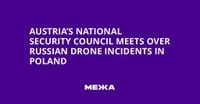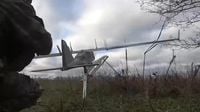On the night of September 9, 2025, the skies above Poland became the stage for a dramatic escalation in the ongoing tensions between Russia and NATO. Nineteen Russian Gerbera drones, bristling with the potential for destruction, violated Polish airspace—a move that would quickly reverberate across Europe and beyond. According to ORF, Polish forces, acting swiftly, managed to shoot down about four of these drones, while the debris from the downed aircraft scattered across several settlements. For the first time ever, hostile drones were neutralized over Polish territory, marking an unprecedented moment in NATO’s history.
The incident did not go unnoticed. Prime Minister Donald Tusk, following a National Security Council meeting, announced that Poland would seek training from Ukraine on how best to counter Russian drone threats. "Poland will receive training from Ukraine on how best to down Russian drones," Tusk stated, highlighting the urgent need for expertise in drone defense. The significance of this collaboration is clear: Ukraine, with its hard-won experience repelling relentless Russian drone attacks, stands as a vital resource for Poland as it bolsters its own defenses.
But Poland was not alone in facing this new wave of hybrid warfare. The Austrian authorities, as reported by ORF, convened their National Security Council on September 17, 2025, to address the incident and the broader threat it posed to European airspace. The Council’s discussions centered on airspace violations, the growing menace of hybrid threats, and the urgent need to update Austria’s security strategy. Defense Minister Klaudia Tanner was vocal in her call to "speed up the implementation of the missile defense project and plans to intensify talks on procuring long-range systems." The Green Party, meanwhile, pressed for a comprehensive review of Austria’s national security posture, underlining the ripple effects of the Polish drone incident across the continent.
The response from NATO was swift and coordinated. On September 12, NATO Secretary General Mark Rutte announced the launch of Operation Eastern Guard, a new mission designed to eliminate drone-related threats on the alliance’s eastern flank. This operation, as detailed by mezha.net, mobilizes resources from member states including Denmark, France, the United Kingdom, and Germany, blending traditional military capabilities with cutting-edge drone defense systems. Just two days later, on September 14, Polish President Karol Nawrocki signed a resolution permitting NATO troops to be stationed on Polish soil as part of the operation—an unmistakable signal of the alliance’s commitment to collective security.
Yet the threat was not confined to Poland alone. On September 14, a Russian Geran-2 drone was detected in Romanian airspace, prompting further condemnation from NATO capitals. The Romanian Ministry of Defence reported that the drone, which penetrated about ten kilometers into Romanian territory, did not pose an immediate threat to civilians and was soon lost from radar, likely having crashed. Romanian F-16s, authorized to shoot down any Russian drone entering their airspace, opted against engagement to avoid endangering people on the ground. As BBC and other outlets reported, these incursions—though not uncommon—have taken on new significance in light of their scale and the deliberate nature of the provocations.
British Prime Minister Sir Keir Starmer minced no words in his response to the crisis. Announcing the deployment of Royal Air Force Typhoons to NATO’s Operation Eastern Sentry, Starmer declared, "Russia’s reckless behaviour is a direct threat to European security and a violation of international law, which is why the UK will support NATO’s efforts to bolster its eastern flank through Eastern Sentry. These aircraft are not just a show of strength, they are vital in deterring aggression, securing NATO airspace, and protecting our national security and that of our allies." RAF Typhoons, operating from RAF Coningsby with tanker support from RAF Voyagers, will join a multinational contingent of NATO fighters in patrolling and defending the alliance’s eastern skies.
The British deployment, as detailed by The Times, is far from routine. It represents a significant build-up of NATO aircraft along the eastern flank, with Danish F-16s, French Rafales, German Eurofighters, Italian and Dutch F-35s all contributing to the effort. The Typhoon, equipped with the advanced MBDA Meteor missile, is particularly well-suited for intercepting drones and cruise missiles at long range. Defence Secretary John Healey emphasized the UK’s resolve: "Russia’s actions are reckless, dangerous, and unprecedented. They only serve to strengthen the unity of NATO. Just as we stand with Ukraine, we will stand with our Polish NATO allies in the face of Russian aggression."
Other NATO members have followed suit. Czechia announced the deployment of a helicopter unit—three Mi-17s and 150 special forces troops—to Poland to assist in the defense against low-flying drones. Czech Defence Minister Jana Černochová underscored the urgency: "It is important that the help comes quickly and that we show Russia our unity. We are ready to send the unit within a matter of days." The Czech Chief of General Staff, Karel Řehka, added that the deployment would last "for up to three months," with flexibility depending on Poland’s evolving needs. The use of helicopters, as seen in Ukraine and Israel, offers a low-cost and effective means of countering drone threats without expending expensive missiles.
Ukrainian President Volodymyr Zelenskyy, never one to mince words, described the latest drone incursions as "an obvious expansion of the war by Russia," accusing the Kremlin of deliberately testing NATO’s resolve with smaller provocations. This strategy, he warned, echoes Russia’s previous tactics in Crimea and the Donbass—incremental advances met with muted responses, paving the way for larger, more dangerous escalations.
Despite the alarming nature of these incidents, no casualties have been reported from Russian drone strikes on NATO soil so far. Nevertheless, the sense of urgency is palpable. Austria’s National Security Council is now expected to deliver concrete decisions on updating the country’s defense strategy, budget, and cybersecurity readiness. Across Europe, governments are scrambling to adapt to the new reality of hybrid warfare, where drones, cyber attacks, and disinformation campaigns blur the lines between peace and conflict.
As the dust settles over Poland and Romania, one thing is clear: the recent drone incursions have galvanized NATO and its partners, prompting an unprecedented level of coordination and military buildup along the eastern flank. Whether this unity will be enough to deter further provocations remains to be seen. But for now, the message to Moscow is unmistakable—Europe is watching, and it is ready to defend its skies.


